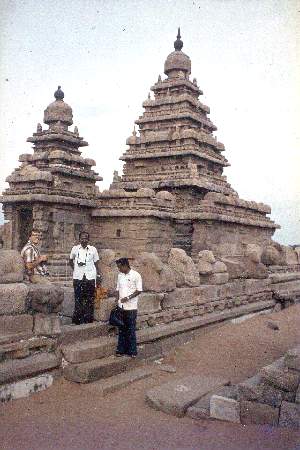

Home | Biodata | Biography | Photo Gallery | Publications | Tributes
Archaeology

 |

Home | Biodata | Biography | Photo Gallery | Publications | Tributes Archaeology |
 |
Manimangalam, today, is a small village about five miles west of Tambaram on the Vandalur - Sriperumbudur Road. However, in the seventh century, A.D., Manimangalam became renowned as the scene of a great battle between the Pallava ruler, Ma$malla, and the Chalukyan monarch, Pulikesin II. Pulikesin had earlier defeated emperor Harsha in the north, and Ma$malla's father, Mahendra I, in the south -- but in Manimangalam he met defeat at the hands of Ma$malla.
Did Ma$malla, in whose reign a multitude of splendid monuments were created at Mahabalipuram, build any structure at Manimangalam to commemorate this victory? The chances are that the answer is 'yes', for there are definite traces left today of a structure belonging to his period.
As one follows the road through the little village, one can see lying on the ground near the local library several granite pillars of the Pallava period. They have proved to be a convenient surface on which to dry cow-dung cakes. If the pillars are cleaned, however, one will in fact find Tamil inscriptions, which belong to the reign of Ra$jendra Chola, in the eleventh century. The portion, which we have read with the help of our college students, is the introductory praising of king Ra$jendra. We may conclude that these pillars must have been part of a temple, which was intact at least until the time of Ra$jendra Chola.
Two of these granite pillars, which are distinguished from the others by having their base carved in the form of seated lions, have been salvaged in the recent past and used as fašade pillars in a nearby, modern temple. We were told that there are other lion pillars lying buried in the same area.
On the basis of a close study of the characteristics of sculpture of the Pallava period, we would hold that the lion pillars of Manimangalam are of a period prior to the reign of Pallava king, Ra$jasim^ha, who built the Kaila$sana$tha temple at Kanchipuram around the beginning of the eighth century, A.D .One of the "lions " has horns and, strictly speaking, must be called a vya$l@a. In general, we have found that the main characteristics of Ma$malla type lions or vya$l$@as are as follows. First their canine teeth are only moderately long and curved backward. Secondly, the manes of the lions are depicted with circular curls of hair. Thirdly, the manes of vya$l@as are depicted with mango-shaped tufts of hair. All of these characteristics are found at Manimangalam.
In contrast, lions carved in the Ra$jasim^ha period have extremely long sabre-teeth and their manes do not show any pattern of curls, either circular or mango shaped. Thus, the characteristics found at Manimangalam are like those of Ma$malla's time and unlike Ra$jasim^ha's. it should be noted that the lions which belong to the period immediately following Ra$jasim^ha's continue to have the Ra$jasim^ha characteristics, plus some others.
With regard to all of the Manimangalam pillars, that portion called the 'torus' is carved as a separate piece. Many of these pieces can be seen lying scattered around on the ground. They are very similar to the type of torus on the pillars of the Ma$malla cave-temples at Mahabalipuram.
The Manimangalam lions have interesting features of their own. Both are provided with head-bands and siraschakras. The band go through siraschakras at the rear side of the pillars and hang down in tassels on the back of the lion's neck. further, it should be noted that these lion pillars have circular padma$ pi$t@as.
The remains of structural stone temples of the pre-Ra$jasim^ha period are extremely rare - and some scholars question the very existence of such structures. Heretofore the only known remains of a pre-Ra$jasim^ha date were the four inscribed granite pillars from Kanchipuram and the granite basement of an apsidal temple at Kuram. Thus the discovery of a Ma$malla structure at Manimangalam should prove a valuable addition to our knowledge of the development of architecture in the pre-Ra$jasim^ha period.
Efforts should be made to uncover the other lion pillars and preserve those lying on the ground before they are destroyed or thoughtlessly removed. It is possible that a search might turn up the base of the original structure, or some inscription of Ma$malla Narasimha Pallava, the greatest warrior king of Pallavas.